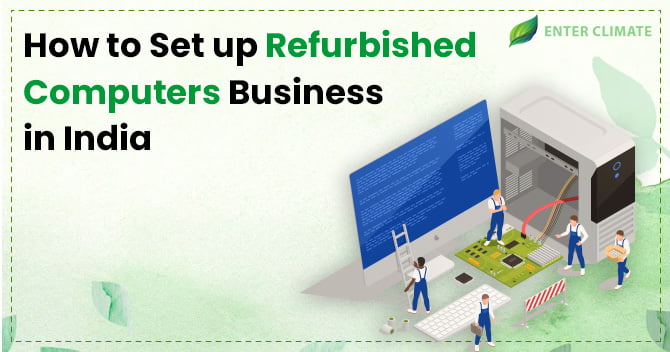How to Set up Refurbished Computers Business in India?
 28 Jul, 2022
28 Jul, 2022 
RefurbishingComputers is a profitable business that can be started with comparatively less hassle than other e-waste businesses. A refurbisher can buy old computers and laptops from bulk consumers(public or private entities)or collect them directly from the consumers. He must check the computers to ensure quality and must be able to refurbish them without incurring much cost. The refurbisher must also ensure that the product will be in demand and be able to sell it without much hassle to new businesses, bulk consumers, schools, NGOs and the retail market. Besides buyers in the market looking for cheaper computers, some environment-conscious buyers and bulk consumers who want computer systems for a limited time also buy refurbished computers. A refurbishing business does not need high capital investment. Still, it will require mandatory authorisation and licences and an efficient collection, repair, marketing, and advertisement plan to grow their business fast and make a decent profit. This approach can be aided by experts who can provide a step by step guidance for authorisation and registration for your computer refurbishing business.
Steps involved in Computer Refurbishing
To start a refurbished computer business, a general idea of how refurbishing works is required. Computer repair skills, IT certifications, and assembly and software installation skills are essential in this line of business. In the following section, we will give you a precise sketch of how you can set up a refurbished computers business in India.
External Inspection: The refurbishing process for computers and laptops starts by inspecting the computer for quality, performance and safety by trained professionals. Boot speed of the computer, display quality and conditions of external ports and power cords are checked to get an idea of how much work and cost the refurbishment process will entail.
Dismantle/dissemble: Disassembly is required to check for the state of internal components like RAM, processor, graphic card, and motherboard and clean or replace them if needed.
Repair or replacement: This is the most critical step in the refurbished computers business. Hardware issues like loose connections, troubleshooting, and dry soldering are repaired and fixed while missing and defective components are replaced. Such parts may include RAM, graphic cards, capacitors, ICs and storage.
Sanitation: All internal and external surfaces must be dusted and cleaned off any marks or stickers. Any cosmetic enhancement that would make the product look new should be done.
Resetting the Computer: Computers often reaches a refurbisher with old data that must be erased to free space and speed up the system. The Factory resetting can provide a fresh look to the user interface and gives the sense of the product being new.
Software installation and licensing: Refurbishers can choose to provide the latest operating system version or leave it up to the buyer to reduce the incurred cost.
Testing and Quality Control: at the final stage, testing the computer system on all parameters, small or big, is a must for a refurbished computers business. It ensures a high standard of business practice and avoids hassle from the customer’s end after wards.
A step-by-step guide to set up Refurbished Computer Business
Step 1: Deciding the Services: Anyone who wants to start a computer refurbishing business must first decide the extent of refurbishing services that will be offered. Refurbishing computer parts like motherboard or graphics card need technical skills while upgrading displays or memory is comparatively easy. For a person new to the market, deciding the refurbishing services to be offered can be critical in making profits.
Step 2: Evaluating Cost Involved: Calculating the initial cost involved in renting space, purchasing machinery and tools, and other factors like workers’ salaries and maintenance are essential.
Step 3: Choosing a location: Deciding the location can be critical in the growth of the refurbished computer business. E-waste Recycling hubs are usually concentrated near big wholesale and retail markets in cities. A refurbisher may choose a similar location as it can provide proximity to the source of computers that require refurbishing and a market for its sale afterwards.
Step 4: Obtaining Licenses and Authorisation: Authorisation from SPCB is mandatory for refurbished computer business and must be obtained. The process has been explained in the following sections for your convenience.
Step 5: Gathering skilled technicians: getting necessary IT skills or hiring personnel from other repairing and training centers with experience in the field is essential as refurbishing damages can cost the business owner heavily.
Step 6: Arranging vendors and suppliers: Quality spare parts and consumables needed in refurbishing must be sourced from suppliers who can guarantee quality and timely service. Transportation of refurbished computers to the buyer can also be provided so that no damage is caused during transit.
Step 7: Marketing and advertisement: refurbished computer businesses should be able to spread the word that cheap and quality substitutes for computers are available to them. Customers of old products often look for a warranty on refurbished computers. Providing such assurance to customers becomes essential to compete in the market, and therefore a short warranty period is usually provided to instill confidence in the refurbished product.
Legal Requirements in Refurbishing
Refurbishing businesses are registered under the Factories Act, 1948, the Companies Act, 1956 or both or district industries centers. After registering the facility with the authority, the first step is to obtain a one-time authorisation for e-waste refurbishing by the concerned SPCB. Refurbishers must keep the record on refurbished computers and other EEE in form 2 of the E-Waste Management Rules, 2016. They also need to submit an annual return in form 3 to the respective SPCBs. Authorised Service Centres of Computer come to underthe definition of refurbisher. They have been directed at the CPCB level to obtain authorisation from respective SPCBs and keep records of refurbishing and filing annual returns to the SPCB. The required documents for authorisation of e-waste refurbishing have been listed below.
Documents required
- Consent to Establish
- Consent to operate(CTO) granted by the concerned SPCB
- Proof of annual installed capacity of plant and machinery.
- Aadhar Card
- Pan Card
- C.A Certificate
- MSME Certificate
- TIN/ GST Certificate
- Layout Plan
- Project Report
- Electricity Bill
- Copy of Agreement with registered recycler/ dismantler
- Copy of valid Authorisation with registered recycler/ dismantler
Opportunities and Scope in Computer Refurbishing
Refurbished Computers are quite popular among youngsters who cannot afford to buy a new computer and need the latest computer configurations. A refurbished computer business can also expand into subsidiary businesses like dealing and stocking computer parts and peripherals, upgrading old computers, data recovery, etc. Buyers who want new computers use exchange programs to dispose of their used laptops and desktops to upgrade to newer models to fund their new device. This, in turn, creates a used but valuable stock with original equipment manufacturers (OEMs)that can be reintroduced into the market through refurbishment. Apart from refurbishing computers available to a refurbisher, some opportunities have been compiled in the following section for interested entrepreneurs entering the refurbishing business[1].
- Additional Services: Besides refurbishing laptops and desktops, the repair of separate parts of computers like video/graphic cards, ROM, laptop screens and monitors are also in high demand. The Refurbished computer businesses can expand their consumer base by refurbishing these costly components.
- Profitable Software installation: Microsoft provides licensed Windows OS and MS Office at special prices for refurbished PCs. The Microsoft Authorized Refurbisher Program enables registered PC refurbishers to purchase low-cost genuine Microsoft software for installation on newly refurbished PCs.
- Dead on Arrival Computers: OEMs often sell non-functional units to refurbishers that get damaged during transit or develop a major fault within the warranty period. These systems may be sold at auctions or directly procured from the dealers.
- Surplus demand for Refurbished computers: many corporates that shifted their mode of operation to online continue to do so. Schools and colleges also adopted online teaching. The pandemic has suddenly increased the demand for second-hand and refurbished computers and laptops. Apart from that, the cheaper and increased internet availability in remote locations of the country has further fuelled this demand.
Conclusion
Refurbished devices are gaining popularity as a lot of awareness is being created through the media. This sector also reduces the carbon footprint made by manufacturing new computers. Refurbished computers businesses are also immune to planned obsolescence practised by many OEM brands as refurbished computers can be upgraded according to the existing demand of the consumers. Nowadays, many refurbishers have expanded their presence on online platforms and have started door-to-door services too. With the current level of infiltration of computers in schools, government offices and homes, the need for cheap alternatives to laptops and computers has increased, which in turn has led to demand for refurbished computers more than ever.













